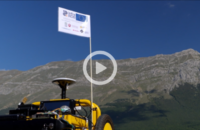For the Gran Sasso highway tunnels, the cycle of extraordinary control activities has been concluded. The operations will be completed about two weeks ahead of the deadline set by the Ministry of Infrastructure and Transport.
For the occasion, Deputy Minister of Infrastructure and Transport Giancarlo Cancelleri, who had kicked off the activities last October, returns under the Gran Sasso precisely to witness the end of the cycle of extraordinary controls.
Since last May, the Ministry has introduced new structural verification methods for all tunnels on the Italian highway network.
In October, the deputy minister had kicked off cleaning activities at the Gran Sasso Tunnel, where a new technique was tested for the first time. Instead of washing, dust and smog deposits were removed from tunnel surfaces with powerful suction machines.
The mechanical removal also included the adoption of a special protocol in the implementation phase. In fact, among the objectives was to avoid even contact and airborne dispersion of the removed dust. As well as the adoption of special precautions and precautions to avoid even the disturbance of fauna with noise and the emission of fumes into the environment outside the tunnels.
This was an impressive job given the size of the two tunnels, which are 20 km long in total.
The one adopted in the Gran Sasso is a new technique, replacing the traditional one that involved washing the surfaces with water and thinners. A technique adopted on the entire highway network. But which presented limitations under the Gran Sasso, because of coexistence with a system of aqueducts supplying the provinces of l’Aquila and Teramo. And because of the interest of the area characterized by the presence of a national park.
Authorizing the new system of cleaning the Gran Sasso with suction was a real race against time that saw the Region, Gran Sasso National Park and the Concessionaire together, who together with the other authorities and the Commissioner proceeded to do all the authorizing verifications (VINCA) in time to comply with the Ministry’s stakes.
The cleaning of the caps was a necessary activity precisely to allow the surfaces of the tunnels to be inspected palm, palm. And to allow the very sophisticated instruments to be more timely and accurate in analyzing the consistency of the concrete some forty years after the construction of the tunnels.
Until 2020, tunnel inspection regulations provided for a quarterly visual inspection and an annual inspection by an accredited engineer or technician. As of May 2020, the MIT adopted a new methodology that resulted in new “guidelines,” which redefined the objectives and methods of inspection of highway infrastructure.
The investigations launched in recent weeks inside the tunnel have been carried out using innovative techniques and machinery such as georadar, through which a wave is propagated inside the canopy and provides a spectrographic image of what is behind the concrete; laser scan, which creates a three-dimensional image of the outside of the canopy, detecting even microscopic anomalies; and thermal imaging, which allows for the detection of water seepage.
Inspectors from a certified outside company-in this case, the engineering firm Rocksoil-then verified on the pantograph what was found during the investigation. They then worked directly under the caps by proceeding with hand-beating the concrete surface so as to detect any voids and doing actual endoscopies in the concrete.
In order to avoid closing one of the Gran Sasso’s tubes entirely by establishing two-way traffic, work under the tunnel followed a phased route.









